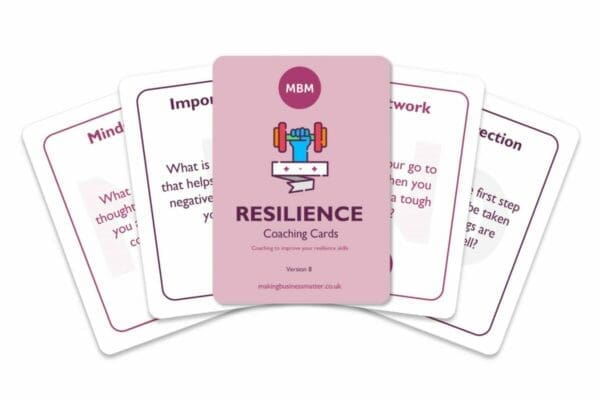Do not pray for an easy life, pray for the strength to endure a difficult one.” – Bruce Lee
The world we live in is volatile, uncertain, and ambiguous. In fact, the recent pandemic is proof of that. However, in order to survive, we must be resilient and nowhere is this more evident than in the workplace. Leaders have faced challenges they had no idea existed. In the face of constant change, they have had to make difficult decisions. In order to stay ahead, they have needed to be extremely adaptable, proactive, and resilient. After all, without resilient leadership, it is impossible to develop and grow a resilient workforce.
But how do you strengthen resilient leadership?
As with any skill, resilience can be taught, learned, and honed with practice; in this article, we’ll look at why is being resilient important, some strategies and examples for how to do that.

>> resilience coaching cards <<
What is Resilience Theory?
Let’s first look at what resilient leadership theory actually is before moving on to examples and techniques for enhancing resilience in leaders.
Resilience is an essential trait of high-performing leaders. To advance and thrive, leaders must cultivate it within themselves. They are also responsible for assisting in protecting the energy of the people in their teams.
When we think of resilient leadership, we often envision bold and brave individuals. People who appear to be immune to setbacks and failure. These people may be resilient, but that isn’t what resilience really is.
Toughening up isn’t the goal of a resilient leader. It is the ability to recover and adjust after setbacks. To keep going in the face of adversity. It’s about learning to be comfortable with discomfort while still leading others with empathy, courage, and conviction.

What are the 7 C’s of Resilience?
1. Competence
Number one is competence, which means knowing all of your skills and what you already do exceptionally well. The things you’ve learned along the way, and the things you’ve picked up during different jobs.
It’s all about reflection. What skills will come in handy when things get tough? What are the skills and competencies required for your role to be successful? Begin by listing all of these and determining whether there are any gaps.
Do you need to invest in some skills to truly ensure that you are prepared for any situation that may arise?
It’s not so much about knowing everything but about having problem-solving skills and knowing the right people so that when things get tough. You should know where to look things up, how to solve and figure things out, or who to talk to.
To reflect on it. Consider the following questions:
- What are some of your key strengths?
- What are your natural talents?
- What are the things that people come to you for help with?
These can be indicators of your unique competencies, and skills that you have acquired along the way.
Sticky Learning ® is 7 times more effective than 1-day training courses. Plus, you will get a Chain of Evidence proving your Return on Investment. Discover soft skills training that changes behaviours long term.

2. Confidence
The second C is confidence, which means that you believe in your own abilities. You have to believe in your own strength and all that you’ve already accomplished. Start by believing that whatever you’ve learned will help you figure things out going forward, that you have what it takes.
You can conduct a CliftonStrengths assessment, for example, or you can begin to reflect on past accomplishments and challenges, looking at everything you’ve already overcome or achieved.

3. Connection
Connection is the third of the seven Cs. To be truly resilient, we must believe that we have people on our side who will catch us if we fall. You need a supportive group.
Who exactly are the people in your life—your friends, your family, your coworkers, your mentors, your peers, your manager, your team. What do they do for you? What are the communities that you’re part of? Have you got any hobbies? Are you part of a club? Who in your life is always there to support you?
Consider reflecting on all the various groups you belong to and identifying the key figures you can really rely on as a way to strengthen this. So, if something happens at work, for example, have someone who understands what’s going on there.
So consider your most important relationships. Then, because relationships are a two-way street, consider what you can do for the other person. How can you strengthen the bonds? So, for each person in your safety network, write down an action to see how you can do something nice or supportive for them in order to build and invest in that relationship.
It is critical that we remember to give as well. And if something happens to you or you require assistance, they will be there. No questions asked.
4. Character
Your character is the fourth C. That means knowing your values, knowing what’s right and wrong, and having a genuine connection to what you truly care about. That is critical for resilience because it will assist you in making difficult decisions. It will help you stay on track.
When things get tough, it will help you see the way forward. You’ll be inspired to go back because you can relate it to the things you value and are most passionate about. It also assists you in forgiving yourself when you make mistakes because when you reflect on your values and why you did the things you did, you will see that you made decisions based on your values.
And, yes, perhaps things did not work out. Perhaps there was a better way to go about things, but your intentions were sound. It’s often much easier to forgive ourselves and feel motivated to try again after that.
So, think about your values. What are your core values? Do you stand for something particular? What are your non-negotiables?
5. Contribution
Contribution is the fifth C in the seven Cs of the resilient leadership toolkit. What have you done to improve the lives of others or the greater good of the world? Is there something that motivates you? What is your mission? That is very important because it will help us find the drive and motivation to try again. You need to understand why you do the things that you do, why you work so hard, and why it’s important to get back up.
So be aware of what you stand for. What do you want to be part of?

To do that, you can start to reflect on your passions, and things that you really care about that excite you and energise you. You can reflect on people that you admire for their contribution. And what about that did you admire? Starting to find some clues of what are the bigger causes that you care about?
It’s not necessary to change the course of history. It could also simply be to have an impact on the people you lead or those in your life. How do you want people to feel when they interact with you? What kind of change do you want to see?
It takes some time to discover your purpose. So keep thinking about it, taking notes, and adding to it and changing it up. At some point, you will be certain of your goal. It will also help you succeed and persevere during difficult times.
6. Coping
Coping is number six, and these are the traditional coping strategies that many people discuss when we discuss resilience. It is about how you cope with and release stress mentally, emotionally, and physically. How do you care for these three aspects of yourself?
Begin to mentally reflect. What can you do to lighten your mental load? Which steps can you take to write down difficult tasks, delegate them, and prioritise your days? What can you do to ease the burden? How can you reduce mental stress?
It is also closely related to your emotional coping strategies.
Mindfulness and meditation are important strategies. How do you deal with stress? Who are the people you can talk to? Maintain regular contact with them. What strategies can you put in place?
Then, physically, how well do you move your body? What is the quality of your sleep and rest? Of course, what do you consume and put into your body?
Consider these things on a mental, emotional, and physical level. How can you develop coping mechanisms to relax and relieve stress? To ensure that our body and mind are in the best condition possible, it is crucial that we take these steps before things get difficult. Furthermore, we are the most energised to face adversity.
7. Control
Finally, control is the final C. You need to remember that you have control over your thoughts, decisions, actions, and behaviours. You can change things.
We often worry about things over which we have no control. We waste emotional energy worrying about things we can’t change or being angry about decisions made by others.
What you can do is choose not to worry about things over which you have no influence or control and instead focus your energy on things over which you have control. This will give you enough emotional energy for your own causes, work, and the things that are important to you.

If we waste energy on things we can’t even influence, we won’t be ready and prepared for when things get tough on our end. A lot of things happened in the last few years that were beyond our control. Many decisions were made about our lives and our lockdown that were not always in our control. But what we can control is how we deal with it. What are the decisions we make for ourselves, our families, and our jobs, and are they difficult?
A key exercise you can do here is to:
- begin reflecting whenever you feel overwhelmed.
- Write down everything you’re worried about.
- Begin with everything that you’re worried about, or whatever causes you to feel a certain way.
- Divide these items into three groups: your circle of concern, your circle of influence, and your circle of control.
Then, Divide Them
Then divide these items into three groups: your circle of concern, your circle of influence, and your circle of control. The difference here is that your circle of control includes things that you can address, change, or act on right away. These are things over which you have complete control. These could include your schedule, when you wake up, what you eat, what you do during the day, and how you structure your day.
The circle of influence is next. These are things you can influence and impact over time by collaborating with the right people, talking to the right people, and inspiring others to act. They are the things over which you have some influence, but not complete control. You may need to collaborate with others to complete these tasks.
Then you have the circle of concern. All of these things are important to us but we have no control over them. We can’t influence those decisions.
What Do I Know With These Thoughts Now?
So, once you’ve organised all of your thoughts into these three categories, here’s what you should do with them:
- Circle of control category: Take immediate action, address the issues that concern you, and find a solution.
- Circle of influence: Start by defining actions. Who do you need to talk to? What do you need to do? How can you start to drive change in that area?
- Circle of concern: You need to release everything written here. These are things that you can’t change. So even if you spend days and hours being upset you can’t change it. You don’t know what’s going to happen and you don’t have any impact on that. So wasting your energy will take away energy from the things that matter and the things that you can actually control.
Reflect on the 7Cs, remind yourself of your competencies and strengths, build your confidence, and review your values. Speak with those in your support network and use the strategies for your coping skills.
The Resilience Spiral
Resilience Risks
The bottom half of the Resilience Spiral depicts the negative suffering you experience as you progress down the spiral. The body, mind, and spirit are all in distress. Recognizing the early signs of a downward spiral can help you fight it.
Resilience Strengths
As efforts are made to live a more resilient lifestyle, the upper half of the spiral shows the progression of positive resilient factors. Moving up the spiral has a positive effect on both the body and the mind.

Image courtesy of The Resilience Institute.
What are the 5 Skills of Resilience?
What makes a person resilient? When faced with a problem, leaders can easily allow the situation to control them rather than taking control of the situation. Effective resilient leadership necessitates leaders acting in a timely, honest, and iterative manner, acknowledging that mistakes are unavoidable and correcting course rather than assigning blame.
Resilient leaders have:
Flexibility
A leader must be able to recover quickly and protect their team. A car bumper is installed to provide a bounce back and protect the passengers in the event of a collision. A resilient leader is an organisation’s car bumper. They can deal with bad news or disgruntled opinions by listening and responding constructively. Being flexible means being open to change, adapting to situations, and seeing different perspectives and possibilities.
The best way to gain flexibility is through feedback. Flexibility and trust increase productivity, and resiliency. Team members take surveys to give honest, direct feedback on a leader’s effectiveness in these areas.
Agility
Leaders must be able to pivot and change direction quickly as needed. Leaders who are open to suggestions and willing to change their ways of doing things will be more agile in difficult situations. We live and work in uncertain environments, especially today, but resilient leaders can shift their focus to meet needs while still nurturing high-performing teams.
Realisticity
A resilient leader is both realistic and optimistic. They can recognise a problem and look beyond the present situation to envision a bright future on the other side of a difficult situation.
It is valuable to acknowledge a problem or bad situation—and the feelings associated with the circumstances—but the key is not getting sucked into the negativity and pessimism. The focus should quickly switch to solutions
Emotional Intelligence

Emotional Intelligence (EQ) is the ability to manage and understand your own emotions as well as the emotions of those around you. High EQ levels enable you to label feelings appropriately and identify how they affect a situation and other people. It is important to be able to express and control emotions in the workplace, but a resilient leader must also be able to interpret and respond to the emotions and needs of others.
The most effective way to improve your emotional intelligence is to become aware of situations in which your natural response may be ineffective. You should intentionally practice adapting your approach to achieve more effective results.
Locus of Control
The belief that one has some control over outcomes, situations, or experiences is referred to as a locus of control. A resilient leader’s locus of control indicates that the focus is on what can be controlled rather than what cannot be controlled. Breaking situations down into controllable and uncontrollable categories makes challenges appear smaller and more manageable.
What is the Relationship Between Leadership and Resilience?
Why is resilience important to leadership? You may be wondering. Leaders’ resilience influences how they think, feel, and perform. It also has an impact on their teams’ performance and engagement.
You will notice in your work that when resilience is high, leadership behaviour is high, stress is low, and people report better team dynamics. Business leaders must adapt and transform at an increasing rate as a result of constant change and technological advancements. You will see a lot of resilient leadership examples in every successful business.
Today’s dynamic complexity demands an ability to thrive in the ambiguous. Unmanaged, it causes anxiety, reduces productivity, and undermines leadership effectiveness. To put it bluntly, the world has changed at such a rapid pace that it has created a significant risk. A risk that, if unabated, will have an impact on the leader, the larger team, and the organisation’s effectiveness and resilience. That risk is a lack of resilient leadership. More specifically, a lack of ability to influence, build and sustain resilience through a dedicated skill set.

Take a look at this resilient leadership pdf to learn more about the impact of resilience in leadership.
What is a Good Example of Resilience?
A manager loses two key employees in a week. They complete the advertising and recruiting aspects of replacing those employees while keeping their workload manageable. Resilience is about capability and the ability to learn. As the example shows, resilient leadership isn’t about suppressing or avoiding negative emotions or experiences. It is about dealing with them using all of your mental, and behavioural abilities.
In What Ways Can Leaders Build Resilience?
Effective Communication
Resilient leadership entails involving others in the organisation’s journey. Leaders must act independently, they must also communicate their strategy to others. The transition process will be much smoother if a new strategy or direction is explained. Leaders should communicate critical information in a variety of formats to ensure that it is received.
Cultivate Positive/ Trusting Relationships
Leaders should concentrate on fostering trust and embracing differences within their teams. Building positive relationships will result in a more adaptable and successful team. It will be more difficult for the leader to make changes if those relationships do not exist. With the right team dynamics and relationships, even drastic changes are possible.
Continuously Learn and Grow
It is critical to stay competitive by learning new technologies, techniques, and strategies. Resilience, like any other skill, can be honed and developed over time. Organisational challenges can provide learning opportunities for open-minded leaders. Every time a leader navigates a crisis, their resilience and perseverance grow. Obstacles are unavoidable, so it’s critical to learn from them.
Promote Change
In order to facilitate change, resilient leaders must be open to change both personally and professionally. A leader must have a vision for the organisation’s future in order to foster change. They must also have the courage to lead change, even when it is difficult. A large part of being a resilient leader is balancing a vision with the reality of an ever-changing landscape.
Encourage Others

Leaders must empower and prepare others for success. Encouraging others creates a positive environment in a team where mistakes and failures are acceptable. By encouraging employees to embrace failure and move forward, leaders will help them develop creative solutions and problem-solving for the future. When someone is struggling, assist them by pointing out areas for improvement and recognising their efforts.
If you want to develop the skills to lead with courage and conviction through challenging times, try this resilient leadership Harvard course.
Importance of Resilience in Leadership
It is your responsibility to guide the organisation through good and bad times. People should be rewarded and celebrated when times are good. However, nothing beats emerging from a storm as a stronger leader and a more cohesive team. Accept the difficult times with open arms and use them to grow yourself and develop the resiliency required for long-term success as a leader.
Resilience is the capacity to bounce back quickly from change, adversity, or misfortune. It is the result of taking a broad view. You can supplement it with a supportive network of professional and personal relationships and use it to become accustomed to being uncomfortable.
Your actions in a crisis serve as a model for those who follow you. Remember that as a leader, your followers are constantly watching you. If you act like a weak leader, those around you will pick up on your leadership style. On the contrary, if you demonstrate resilience and strong leadership skills, they will remember that lesson and strive to become more resilient themselves.
The Takeaway
Resilience is an essential trait of high-performing leaders. To advance and thrive, leaders must cultivate it within themselves. It’s about learning to be comfortable with discomfort while still leading others with empathy, courage, and conviction. To achieve true resilient leadership, we must believe that we have people on our side who will catch us if we fall. If you want to know more about resilient leadership and discover how to embody a calm and stable leadership presence amid daily pressures, take a look at this resilient leadership book.
What are the qualities of a good leader? Check out our great leadership article to know more.




